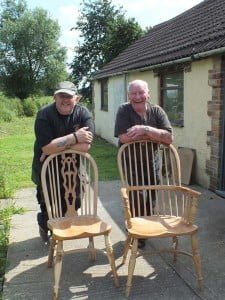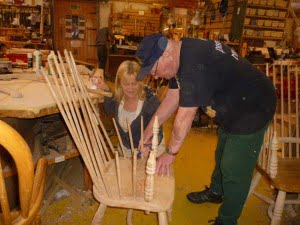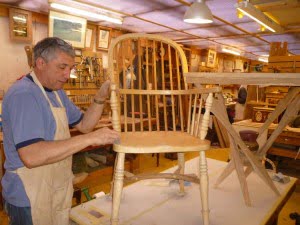Tom Thackray, the UK’s leading Windsor chair maker, has just spent a week teaching woodworking students at the Chippendale International School of Furniture how to make Windsor chairs.
He first met Anselm when he was running his Thomas Chippendale School in South Carolina then Oregon, and has been coming to Scotland to the Chippendale School for the last 15 years.
Tom introduces the students to the Windsor chair, Britain’s national chair, at his short lectures on their history. During the week, the students make a stick-back Windsor chair. Using local ash, they learn to turn, bend and drill the wood. One of the most challenging stages is drilling the holes.
“The Chippendale School is the best furniture school in Britain. I’ve worked in America and Japan but this is the only cabinet making college in the UK where I run my Windsor chair making course.
“I can’t believe the diversity of woodworking techniques they learn here. The students learn a lot here and there’s a wonderful mix of different cultures. Some of the work they do is stunning, but they can only do it because of the quality of the woodworking teaching staff.”
A Windsor chair is built with a solid wooden seat into which the chair-back and legs are round-tenoned, or pushed into drilled holes (source: Wikipedia). The seats of Windsor chairs were often carved into a saddle shape for comfort. Traditionally, the legs and uprights were usually turned on a pole lathe. The back and sometimes the arm pieces (if there any) are formed from steam bent pieces of wood. There are seven distinctive forms of Windsor chair.

Talking about the origins of Windsor chairs, Tom says: “There are no certainties, but it’s thought that the early form of the chair in the sixteenth century was just a stool made from a plank of wood, then some people decided to put backs on them.
“From about the 17th century and early 18th century towns in the Thames Valley around Buckinghamshire specialised in making Windsor chairs, mostly using beech. High Wycombe was the centre and Windsor became the distribution hub which served London in particular. It was a chair for the masses; millions were made in huge workshops where framers would put all the individually crafted pieces together.
“The story is that the chairs were stacked high on wagons; the roads were so rutted, the driver could go to sleep and the cart followed the ruts like train tracks! The popularity of the Windsor chair spread even wider in the 19th century when the railways filled their wagons with them.
“There are also records of ‘Wyndsor’ chairs being taken by immigrants to New England in the US.”

It is common to find American Windsors made in the 18th century that contain pine, bass or tulip poplar for the seat. Hardwoods such as maple are stiff so were used for the undercarriage. Oak, ash, and hickory all rive (split) and steam bend nicely, and therefore work well for the spindles.
“One myth about the source of the name is that George III sheltered in a cottage when he was out hunting. He admired the owner’s chairs so much that he ordered some for his palace, and they became known as Windsor chairs.
“We know that Thomas Chippendale added legs to the chair, similar to Queen Anne legs, and a back, which became known as the Chippendale splat. Fancy woods like mahogany, yew and walnut were used and Windsor chairs became popular with the rich who liked to use them in their kitchens.”
Tom Thackray has a small woodworking school and workshop in Doncaster in Yorkshire where he teaches Windsor chair making. He was originally a joiner before making miniature Windsor chairs in 1972. His son-in-law, Steven Langton, who has been working for him for 32 years and is a “fantastic craftsman”, will be taking over the workshop.
“Steven is an excellent bench joiner and Windsor chair framer,” says Tom. “Originally a miner, he then worked as a cabinet maker on boats. He’s a hard worker and always in the workshop.”
Concluding on the Chippendale School, Tom says: “The furniture school’s absolutely brilliant. If students need anything like tools, Anselm orders them express delivery for next day delivery. It wouldn’t be possible to do that if the school wasn’t private.”

Tom Thackray can be contacted via tomthackray@btinternet.com
